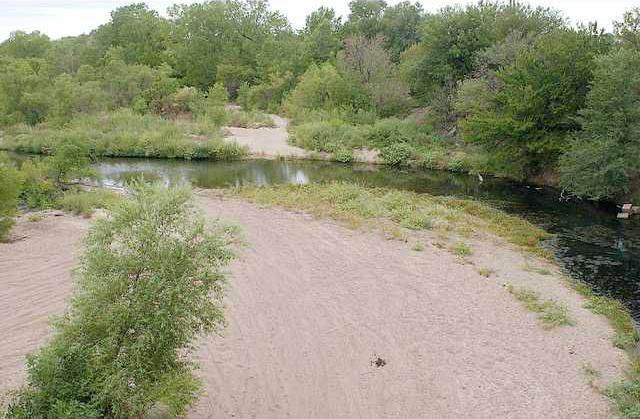MANHATTAN – The Plains-parching drought gripping North American has caused dramatic changes in native fish communities, including those that call Arkansas River home, a Kansas State University researcher said. These changes could have a damaging impact on the health of the Ark as it trickles around Great Bend.
“A couple of key species that we have been studying have virtually disappeared where they historically were abundant,” said Keith Gido, a KSU biology professor who studies fish ecology and conservation of aquatic systems.
Gido and his team study state and federal endangered and threatened fish species in river ecosystems, including the Arkansas, Kansas, Gila, San Juan, Red and Platte rivers. He travels to these different rivers to study imperiled species such as the Colorado pikeminnow, the loach minnow, the spikedace in New Mexico and the plains minnow and silver chub in Kansas.
“These issues are very relevant to central Kansas,” Gido said. “In particular, the Arkansas River is one of the most heavily impacted rivers.”
Historically, he said, the river flowed with much greater volume and did not dry up nearly as often, as it does upstream of Great Bend. “There are also several fish species like the plains minnow and Arkansas River shiner, that historically occurred in the river that are gone now.”
Before the drought, Gido’s team observed more than 300 silver chub in the Ninnescah River in southern Kansas in summer 2011. In 2012, after the second consecutive year of severe drought, his team saw three silver chub during their sampling. They found zero silver chub in spring 2013.
“We are in a conservation crisis,” Gido said. “Our fish communities have changed dramatically and we are losing a lot of native species.”
Why is this a concern? Maintaining diversity is important to maintain healthy river ecosystem functions, Gido said. As part of the ecosystem, fish can influence the cycling of stream and river nutrients. Streams filter nutrients that flow to rivers or other large bodies. When this balance is off, too many nutrients can result in negative effects, such as harmful algae blooms.
A lot of native species of fish also provide recreational opportunities, so there is a societal interest in conserving native fish, Gido said.
How this happens
Gido said two activities – river fragmentation and groundwater withdrawals – largely affect aquatic systems and native fish species in the Great Plains. When combined with the drought, these two activities result in dramatically reduced fish communities and lower species diversity. River fragmentation occurs when barriers, such as dams, break up the long sections of connected river and create shorter segments.
Gido and his research team – including Joshuah Perkin, a postdoctoral researcher and 2012 Kansas State University doctoral graduate in biology, and Thomas Turner, a population geneticist at the University of New Mexico – have spent years studying how river fragmentation affects fish communities in Great Plains rivers. They are currently studying the genetic diversity of populations in different rivers and different fragment sizes.
In previous research, Perkin and Gido found that river fragments less than 100 kilometers make it difficult – if not impossible – for certain fish species to survive. The research appeared in the journal Fisheries.
“Some fish species will release their eggs into the river and these eggs have to drift downstream for a certain distance to develop,” Gido said. “They basically cannot persist in fragments less than 100 kilometers.”
Additionally, reservoirs and ponds behind dams often are stocked with nonnative fish, such as largemouth bass, that can move into the stream fragments and prey on native fish. This increases the effects of shrunken rivers.
“As the water levels decline, if you have a nonnative predator in the system, then the predators’ effects are much stronger and have a more drastic effect on fish,” Gido said. “We have seen a gradual decline in native diversity over time. The drought exacerbates any of the effects because with fragmentation, if the stream is dry and the water is lower, the fish are unable to move around a barrier.”
What can be done?
Gido said countermeasures, such as removing nonnative fish predators, may prevent more native fish from disappearing. Nonnative predator removals are currently under way in the San Juan and Gila rivers, Gido said.
“It might not be something that you can do all the time, but during drought conditions it might be possible to remove predators to give native fish a chance and maintain diversity,” Gido said.
“It’s really a challenge because you have things like dams and nonnative sport fish that benefit society, but they have a negative effect on native fish,” Gido said. “Research agencies have a challenging problem of managing these recreational opportunities but also preserving the natural diversity. We want to find more information about how this system works and how these things can coexist.”
There is a new dam modification in Wichita that might help some, Gido said. This will allow fish move up and down the river in that span.
Gido is involved in several additional research projects. Two projects involve western desert fish in the Colorado River system. The Bureau of Reclamation and the Great Plains Landscape Conservation Cooperative have funded the research.
The researchers also are studying streams at the Konza Prairie Biological Station to understand how the presence of fish – particularly grazing minnows – influences the ecosystem. The project is part of a large-scale $3.3 million National Science Foundation grant to study stream ecosystems in Kansas, Puerto Rico, Georgia and Alaska.
Jennifer Tidball of the KSU Communications and Marketing contributed to this report.
Study: Drought impacting fish populations
Changes may have long-term effects on river health





